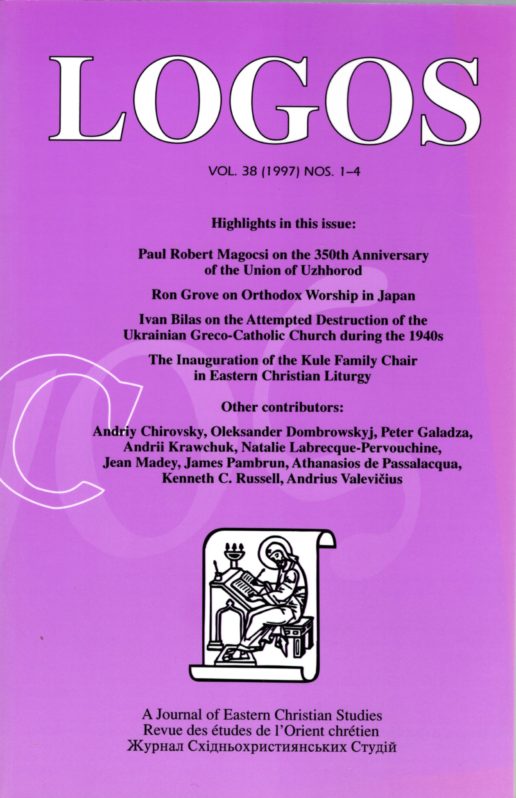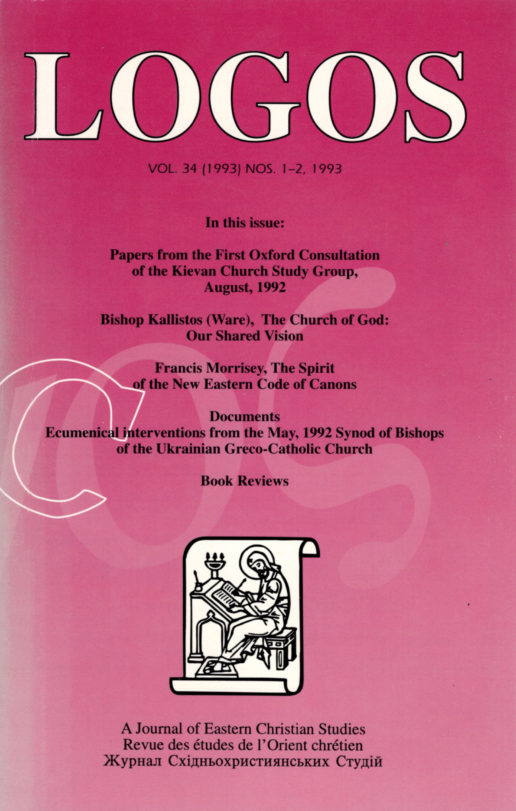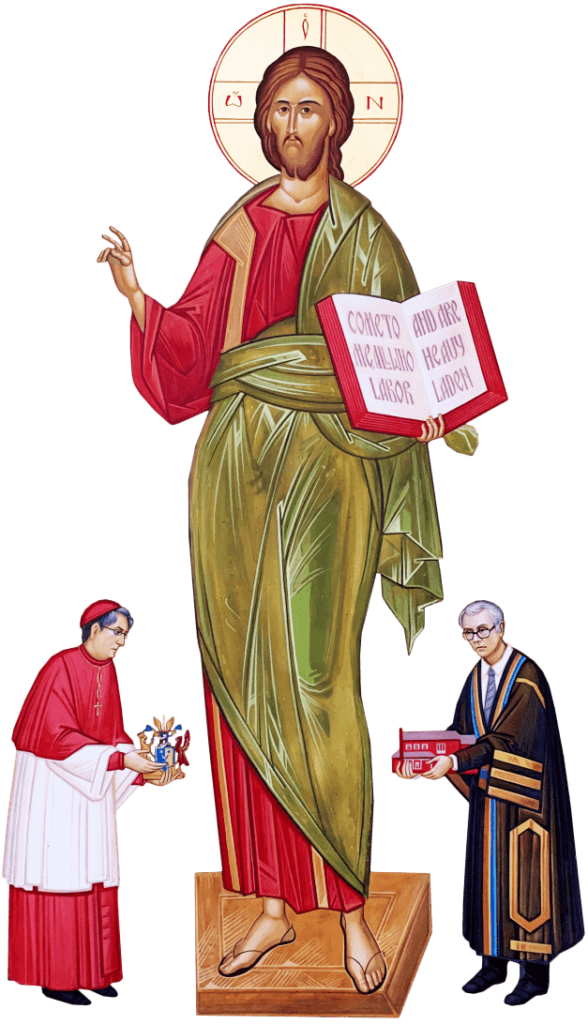Description
Table of Contents (PDF)
Editorial
Another Miracle from Metropolitan Andrey Sheptytsky
Andriy Chirovsky (1)
Articles
“Filled with the Visible Theophany of the Lord: Reading Dionysius East and West”
John D. Jones (13)
Abstract
This article is the latest in a series of papers in which the author has explored how the Divine Names and Mystical Theology of Dionysius the Areopagite have been read in terms of three “frameworks”: Neoplatonic, Greek patristic/Orthodox Christian, and Medieval Latin scholastic. In this article, the author focuses on Dionsyius’s reference to the Transfiguration of the Lord (DN 1.4, 592B-C) and the sort of embodied knowledge we can have of God in theophanic experiences. This text provides a very good example for contrasting the Latin scholastic and Orthodox/Greek patristic interpretations of Dionysius. It also provides an excellent example of a text that cannot be accommodated within a strictly Neoplatonic interpretation of the Divine Names. The author spends most of the article examining the quite different frameworks in which St. Gregory Palamas, on the one hand, and Sts. Albert the Great and Thomas Aquinas, on the other hand, interpret this text. In the end the author shows that these different frameworks for interpreting Dionysius’s reference to the Transfiguration rest on quite different epistemologies.
Резюме
Ця стаття є останньою у серії праць, в яких автор досліджував яким було розуміння Божественних Імен та містичного богослов‟я Діонісія Ареопагіта у трьох „рамках”: нeоплатонічній, грецькій патристичній (святоотцівській)/православно-християнській та латинській середньовічно-схоластичній. У цій статті автор зосереджує свій погляд на посилання Діонісія на Переображення Господнє (DN 1.4, 592B-C) та своєрідне втілене знання про Бога, яке ми можемо отримати через досвід богоявлення. Цей текст є чудовим прикладом протиставлення латинської схоластичної та православної/грецької патристичної (святоотцівської) інтерпретацій Діонісія. Він також є прикладом тексту, який не можна розглядати виключно в світлі неоплатонічної інтерпретації Божественних Імен. Більшу частину статті автор присвячує розгляду зовсім інших „рамок”, в яких цей текст тлумачили св. Григорій Палама, а також святі Альберт Великий та Тома Аквінський. Наприкінці автор показує, що ці різні „рамки” трактування посилання Діонісія на Преображення, опираються на досить відмінні гносеології.
On the “Anti-Semitism” of Pavel Florensky, a New Martyr
Robert F. Slesinski (43)
Abstract
The author, a leading scholar on Pavel Florensky for three decades, here re-evaluates some of his views of the great Russian thinker in view of recently discovered evidence. Though a brilliant mind who was killed by the Communists – and as a result considered by some a “new martyr” and perhaps also a saint, albeit an unofficial one – Florensky seems, in two places at least, to have been unguarded in making comments that by the standards of today would be reprobated as anti-Semitic. Through a careful and discerning consideration of these comments in view of the rest of Florensky’s corpus, the author concludes that they are but blemishes that do not come close to destroying the justly towering reputation of Florensky as a scholar of wide-ranging and extraordinary erudition, a reputation made all the more outstanding by his faithful Christian and priestly witness to the end at the hands of a firing squad in 1937.
Резюме
Автор, провідний знавець Павла Флоренського протягом трьох десятиліть, повторно переоцінює деякі свої погляди на великого російського мислителя у світлі нових знайдених нещодавно доказів. Флоренського вбили комуністи, попри його блискучий розум, через що його почали вважати „новомучеником”, а навіть святим, хай і неофіцій-ним. Однак схоже, що Флоренський принаймні двічі мав необережність висловити коментарі, які за сьогоднішніми стандартами були б засуджені як антисемітські. Ретельно та проникливо розглянувши ці коментарі з точки зору решти праць Флоренського, автор приходить до висновку, що вони є лише недоліками, які не здатні знищити справедливо високу репутацію Флоренського як ученого з чималою та надзвичайною ерудицією, репутацію, яку зробили видатною його християнське та священиче свідоцтво, що тривало до самого кінця, аж до розстрілу в 1937 році.
Notes, Essays, Lectures
Canonical Reflections on the Recent Pastoral Letter from the Melkite Greco-Catholic Eparchy of Newton (PDF open access article)
Alexander M. Laschuk (63)
The Pœnitentiale Theodori in Theological Perspective: Soteriological Aspects of Confession according to Theodore of Tarsus
James Siemens (83)
Book Reviews
Antoine Arjakovsky, En attendant le Concile de l’Église Orthodoxe (Paris: Cerf, 2011), 682 pp.
Michael Plekon (93)
Thomas Asbridge, The Crusades: The Authoritative History of the War for the Holy Land (New York: Harper Collins, 2010), 767 pp.
Michael Lower (97)
Allen Brent, Cyprian and Roman Carthage (Cambridge University Press, 2010), xv + 365 pp.
Bradley J. Daugherty (100)
E.D. Karampetsos, Dante and Byzantium (Somerset Hall Press, 2009), 194 pp.
Anthony Esolen (104)
Alexander I. Negrov, Biblical Interpretation in the Russian Orthodox Church (Beiträge zur historischen Theologie, 130) (Tübingen: Mohr Siebeck, 2008), 348 pp.
Danylo Kuc (108)
Stefano Parenti. A Oriente e Occidente di Costantinopoli. Temi e problemi liturgici di ieri e di oggi. Monumenta Studia Instrumenta Liturgica 54 (Città del Vaticano: Libreria Editrice Vaticana, 2010), 348 pp. + 16 colour plates.
Daniel Galadza (111)
Paul Evdokimov, Orthodoxy, trans. Jeremy Hummerstone (Hyde Park NY: New City Press, 2011), 375 pp.
Michael Plekon (115)
Chris Hann and Hermann Goltz, eds., Eastern Christians in Anthropological Perspective (Berkeley, CA: University of California Press, 2010), 375 pp.
Myroslaw Tataryn (118)
John McGuckin, ed., The Encyclopedia of Eastern Orthodox Christianity, 2 vols. (Wiley-Blackwell, 2011).
Adam A.J. DeVille (121)
Thomas Pott, Byzantine Liturgical Reform: A Study of Liturgical Change in the Byzantine Tradition, trans. Paul Meyendorff (Crestwood, NY: St. Vladimir’s Seminary Press, 2010), 293 pp.
Peter Galadza (124)
Susan Tavassoli, Christian Encounters with Iran: Engaging Muslim Thinkers After the Revolution (London: I.B. Taurus, 2011), 304 pp.
James Bockmier (132)
Radu Bordeianu, Dumitru Staniloae: an Ecumenical Ecclesiology (T&T Clark, 2011), 240 pp.
Adam A.J. DeVille (137)
Stéphane Verhelst, Liturgia Ibero-Graeca Sancti Iacobi. Editio – translatio – retroversion – commentarii (Jerusalemer Theologisches Forum 17, Münster: Aschendorff Verlag, 2011), 456 pp. + 8 colour plates.
Daniel Galadza (142)
Briefly Noted (147)
Contributors (161)
Language: English, French, Italian, Ukrainian
Softcover: vi, 182 pages
Publisher: The Metropolitan Sheptytsky Institute of Eastern Christian Studies
ISSN: 0024-5895
Digital File: $15
Size: 2 MB
A link to the PDF file of this title will be sent to you. The PDF file is for your personal use only. You may not copy, share, publish, or sell the file. Protected by copyright of the Metropolitan Andrey Sheptytsky Institute of Eastern Christian Studies.






